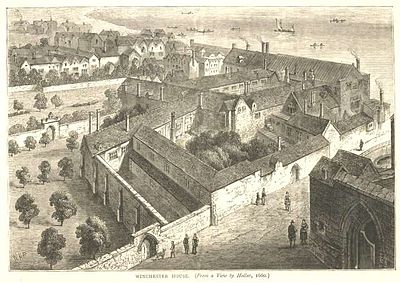
Winchester Palace was a 12th-century palace which served as the London townhouse of the Bishops of Winchester. It was located in the parish of Southwark in Surrey, on the south bank of the River Thames on what is now Clink Street in the London Borough of Southwark, near St Saviour's Church which later became Southwark Cathedral. Grade II listed remains of the demolished palace survive on the site today, designated a Scheduled Ancient Monument, under the care of English Heritage.

Thomas Goodwin, known as "the Elder", was an English Puritan theologian and preacher, and an important leader of religious Independents. He served as chaplain to Oliver Cromwell, and was imposed by Parliament as President of Magdalen College, Oxford, in 1650. Christopher Hill places Goodwin in the "main stream [sic] of Puritan thought".

Philip Wharton, 4th Baron Wharton was an English soldier, politician and diplomat. He was a Parliamentarian during the English Civil War.

Philip Nye was a leading English Independent theologian and a member of the Westminster Assembly of Divines He was the key adviser to Oliver Cromwell on matters of religion and regulation of the Church.
Francis Cheynell (1608–1665) was a prominent English religious controversialist, of Presbyterian views, and President of St John's College, Oxford 1648 to 1650, imposed by the Parliamentary regime.
Charles Herle (1598–1659) was a prominent English theologian, of moderate Presbyterian views.

The Battles of Weymouth, and the associated Crabchurch Conspiracy occurred in 1645, during the English Civil War, when several royalist plotters within the twin towns of Weymouth and Melcombe on the Dorset coast conspired to deliver the ports back into the control of Charles I.
Henry Parker (1604–1652) was an English barrister and political writer in the Parliamentarian cause.

William Kiffin (1616–1701), sometimes spelled William Kiffen, was a seventeenth-century English Baptist minister. He was also a successful merchant in the woollen trade.

Charles Trimnell (1663–1723) was an English bishop. He was a Whig in politics, and known for his attacks on High Church views, writing on the subordination of the Church of England to the state. After the accession of George I of England in 1714 he was in the royal favour and influential.
John Wilde was an English lawyer and politician. As a serjeant-at-law he was referred to as Serjeant Wilde before he was appointed judge. He was a judge, chief baron of the exchequer, and member of the Council of State of the Commonwealth period.
Sir Henry Mildmay was an English politician who sat in the House of Commons at various times between 1621 and 1659. He supported the Parliamentarian cause in the English Civil War and was one of the Regicides of Charles I of England.
Dr. Calybute Downing (1606–1643) was an English clergyman, a member of the Westminster Assembly. Also a civil lawyer, he is now remembered for political views, which moved from an absolutist position in the 1630s to a justification of resistance to authority by 1640, within a contractarian setting.
Sir Nicholas Crispe, 1st Baronet was an English Royalist and a wealthy merchant who pioneered the West African trade in the 1630s; a customs farmer ; Member of Parliament for Winchelsea Nov. 1640-1 ; member of the Council of Trade and for Foreign Plantations ; and Gentleman of the Privy Chamber from 1664. He was knighted in 1640 or 1641 and was made a baronet in 1665. He died in February 1666 (O.S.) aged 67.

The siege of Basing House near Basingstoke in Hampshire, was a Parliamentarian victory late in the First English Civil War. Whereas the title of the event may suggest a single siege, there were in fact three major engagements. John Paulet, 5th Marquis of Winchester owned the House and as a committed Royalist garrisoned it in support of King Charles I, as it commanded the road from London to the west through Salisbury.

Richard Herbert, 2nd Baron Herbert of Chirbury was an Anglo-Welsh Member of Parliament, a Royalist who fought with the rank of colonel in the English Civil War, and a peer whose membership of the House of Lords was curtailed by its abolition in 1649.
William Ogle, 1st Viscount Ogle was an English soldier and politician who sat in the House of Commons from 1640 to 1643. He fought on the Royalist side in the English Civil War.
An Apologeticall Narration, Hvmbly svbmitted to the Honourable Houses of Parliament. By Tho: Goodwin, Philip Nye, Sidrach Simpson, Jer: Burroughes, William Bridge. London, Printed for Robert Dawlman, M.DC.XLIII. [1643] was a theological tract submitted by five Independent preachers to the English Parliament on 3 January 1644 as a part of the debates taking place during the Westminster Assembly.
John Moseley was a lieutenant colonel in the Parliamentarian Army and Governor of Aylesbury during the First English Civil War.

Wardour Castle in Wiltshire was besieged twice during the First English Civil War; once in May 1643, and then again between November 1643 and March 1644. During the first siege, a Parliamentarian force of around 1,300 men led by Sir Edward Hungerford attacked the castle, which was the home of Thomas Arundell, 2nd Baron Arundell of Wardour, a prominent Catholic and Royalist. Arundell was absent, fighting for the King at the time of the attack, and the defence was led by his wife, Lady Blanche Arundell, in command of 25 soldiers. The siege was started on 2 May, and lasted for a week before the Parliamentarians forced Lady Arundell to surrender on 8 May. The Parliamentarians subsequently garrisoned the castle with 75 men, led by Colonel Edmund Ludlow.










